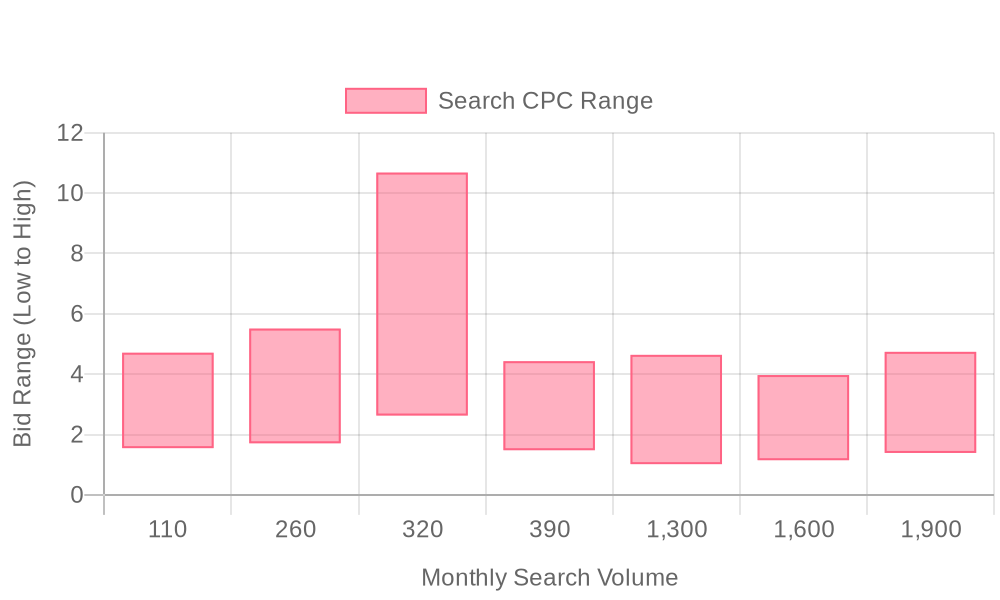
Supercharge your lead generation with a FREE Google Ads audit - no strings attached! See how you can generate more and higher quality leads
Get My Free Google Ads AuditFree consultation

No commitment
Supercharge your lead generation with a FREE Google Ads audit - no strings attached! See how you can generate more and higher quality leads
Get My Free Google Ads AuditFree consultation

No commitment
In the realm of digital marketing, Google Ads offers an unparalleled platform for swiftly capturing high-intent search traffic, particularly for businesses within the health advocacy sector. This dynamic tool stands out by allowing service providers to reach decision-makers precisely when they're searching for services, bridging the crucial gap between awareness and engagement in a strategic, data-driven way. For health advocacy services, the power of Google Ads lies in its ability to refine targeting and improve ROI, connecting online and offline marketing efforts seamlessly. From intercepting prospective clients at the moment of need—such as individuals seeking health information or aid services post-event—to measuring success through detailed analytics that attribute value from click to conversion, Google Ads represents a critical component of a robust marketing strategy. However, the challenge of missing high-value prospects, often due to traditional CRMs not tracking anonymous visitor interactions, remains a hurdle. Modern solutions now allow businesses to identify these key visitors and ensure ad spend targets genuine decision-makers, reducing the risk of lost opportunities.

Health advocacy organizations operate in a complex digital landscape where compliance, precision, and trust are vital for success. By leveraging Google Ads, these organizations can connect with individuals seeking support, education, and guidance, translating digital visibility into measurable impact. For a hands-on approach, review this step-by-step guide to launching effective Google Ads campaigns for healthcare businesses, which covers core setup and optimization strategies.
Strategic use of Google Ads for Health Advocacy Services begins with hyper-targeted keyword and audience research. Focusing on nuanced patient needs and intent-based behaviors ensures that campaigns reach people actively searching for support with insurance appeals, access to care, or patient rights advocacy. With regulatory boundaries in place, campaigns must prioritize compliance with Google Ads healthcare policy, avoiding restricted language while still speaking directly to user pain points.
Landing pages and creative content should deliver a seamless, personalized experience. Tailored messaging fosters trust and encourages conversion, especially when aligned with the specific advocacy services highlighted in each ad group. Integrating real-time visitor identification allows marketers to go beyond anonymous traffic, pinpointing which organizations or individuals are engaging and where they are in the journey.
Consistent testing and optimization are essential for sustained ROI. Running multivariate experiments on copy, calls-to-action, and landing page layouts uncovers what resonates most with different audiences. Using advanced conversion tracking, organizations can attribute both online and offline actions—such as inbound calls or appointment bookings—directly back to specific ads, providing a holistic view of campaign performance.
Amplifying results further requires integrating cross-channel marketing strategies. Dynamic audience syncing ensures that as leads progress through the funnel, they receive relevant messaging across all touchpoints. By syncing enriched audiences and CRM data into Google Ads and other platforms, health advocacy teams can coordinate their outreach, ensuring no opportunity is missed and maximizing the efficiency of every marketing dollar. Ready to take your campaigns further? Get started for free with Sona.

Health advocacy services operate in a landscape where urgency, trust, and precise communication directly impact client outcomes. Digital advertising platforms such as Google Ads empower these organizations to reach individuals and families in moments of real need, delivering critical service information at decision-defining times. By leveraging intent signals, health advocacy marketers can engage both broad and specialized audiences, ensuring that support reaches those actively searching for guidance on complex healthcare issues.
Google Ads for Health Advocacy Services becomes particularly valuable in driving targeted visibility for time-sensitive offerings, such as insurance appeals or patient navigation during open enrollment periods. Paid campaigns can rapidly outpace slower organic methods, providing a responsive channel for critical updates, legislative changes, or resource availability. Marketers seeking inspiration for effective campaign planning can explore real-world Google Ads examples for healthcare. This nimbleness allows health advocates to deploy campaigns swiftly, capturing audience attention during spikes in demand—such as policy shifts or public health emergencies.
Geographic targeting further extends the reach of health advocacy organizations, enabling expansion into underserved or emerging regions without requiring significant on-the-ground resources. Marketers can adjust campaigns to focus on specific cities or counties, ensuring local relevance and compliance with regional healthcare advertising regulations. By layering geo-targeting with real-time audience signals, health advocates maximize impact where support is most urgently needed.
Integrating Google Ads with holistic marketing analytics provides a closed-loop view of campaign effectiveness, measuring ROAS and guiding continuous optimization. Static, one-size-fits-all campaigns often fail to resonate with the diverse needs of patients and caregivers. Advanced marketing intelligence platforms empower organizations to segment audiences based on healthcare journeys, allowing for personalized messaging that reflects the unique barriers and motivators of each client segment. For organizations ready to see the impact, get started for free with Sona to drive measurable outcomes across both online and offline channels.

Growth-focused health advocacy services can accelerate pipeline by aligning digital presence with how decision-makers search, research, and engage. Modern organizations thrive by combining data-driven keyword discovery, competitive intelligence, and strategic content placements that move beyond legacy marketing silos. Sophisticated analytics reveal which market segments are underserved, surfacing new verticals and empowering teams to invest resources where demand outpaces supply. For deeper insight into data-driven content strategy, explore our in-depth blog articles on marketing analytics, or get started for free with Sona to see how advanced analytics can support your growth.
Audience segmentation in health advocacy services is a proven approach to reaching the right individuals with relevant support, information, and resources. By strategically grouping audiences based on their needs and behaviors, organizations can prioritize high-impact interactions and maximize the return on every advertising dollar. Learn more about real-time audience segmentation to boost targeted outreach.
Segmenting outreach ensures messaging aligns with a user’s stage in the care journey, from initial awareness to post-resolution engagement. The right segmentation framework empowers B2B revenue teams to personalize campaigns, streamline demand generation, and deliver measurable outcomes in a tightly regulated industry. Explore actionable strategies in our marketing analytics blog for deeper insights.
Ready to drive better results from your health advocacy campaigns? Get started for free with Sona.

| Industry | Keyword | Monthly Search Volume | Competition Level | Low Bid | High Bid |
| Health Advocacy Services | health advocacy services | 110 | LOW | 1.55 | 4.71 |
| Health Advocacy Services | medical advocate near me | 260 | MEDIUM | 1.71 | 5.51 |
| Health Advocacy Services | mental health advocates near me | 320 | MEDIUM | 2.63 | 10.68 |
| Health Advocacy Services | patient advocate services near me | 390 | LOW | 1.48 | 4.43 |
| Health Advocacy Services | medical billing advocate | 1300 | LOW | 1.02 | 4.64 |
| Health Advocacy Services | medical advocate | 1600 | LOW | 1.15 | 3.97 |
| Health Advocacy Services | health care advocate | 1900 | LOW | 1.39 | 4.74 |
A successful keyword strategy for Google Ads in health advocacy services requires a blend of patient-focused language, regulatory compliance, and data-driven refinement. Building campaigns around highly relevant search intent ensures that each dollar spent connects advocacy organizations with those actively seeking guidance, support, or navigation within the healthcare system. Intent-rich terms such as “health advocacy Google Ads strategies” and “effective healthcare ad targeting options” tap into both professional and patient audiences, drawing in individuals who are both decision-makers and direct beneficiaries. For campaign inspiration and best practices tailored to healthcare organizations, review these Google Ads examples for healthcare.
Target keyword lists should be segmented by service line and audience, using phrases that reflect urgent needs and common pain points. Examples include “insurance appeal support,” “patient rights advocate,” and “help with denied medical claims.” Geo-modified keywords like “healthcare advocacy near me” and “local patient advocate services” can narrow the audience further, ensuring outreach is both actionable and compliant with regional healthcare laws. To refine your paid search targeting, explore additional actionable strategies for healthcare Google Ads.
Negative keywords are essential for maintaining campaign efficiency and compliance. Excluding terms such as “jobs,” “symptoms,” “free diagnosis,” and unrelated medical specialties prevents wasted spend on irrelevant clicks and keeps the message tightly focused on advocacy rather than clinical care. This approach not only optimizes budget allocation but also ensures that ad impressions are delivered to audiences ready to engage with advocacy solutions, rather than those searching for unrelated medical information. For more tips on optimizing your ad performance and compliance, visit our blog for in-depth articles.
Marketers can further refine these segments by leveraging real-time audience insights and unified visitor profiles. By pinpointing which companies or organizations are visiting a health advocacy site and understanding their journey across multiple channels, teams can dynamically update audience lists within Google Ads. This continuous feedback loop enables keywords and ad groups to adapt as new high-intent leads emerge and existing contacts progress through the funnel. Integrating CRM and ad platforms ensures that every conversion—from online form fills to offline consultations—is accurately attributed, providing a comprehensive view of campaign ROI and audience quality. Ready to optimize your health advocacy campaigns? Get started for free with Sona.

A results-driven Google Ads strategy for health advocacy services enables organizations to reach patients and caregivers at critical moments. Modern revenue teams gain a competitive edge by aligning ad tactics with the unique sensitivities of healthcare audiences, ensuring compliance and maximizing return on investment. Tight integration of visitor intelligence, intent data, and CRM synchronization further elevates campaign outcomes—see how a step-by-step Google Ads guide for healthcare can help teams get started.
Keyword development serves as the foundation for every successful health advocacy campaign. Start by grouping keywords according to specific service lines—such as insurance navigation, patient rights counseling, or chronic care support—using contextual modifiers that reflect actual user intent. Incorporate geographic tags like city, state, or region to create a localized approach, ensuring ads are shown to users seeking support within relevant jurisdictions.
Long-tail keyword queries drive higher engagement by mirroring real-time informational needs. Phrases such as “help with denied medical claims in Austin” or “Medicaid advocacy Chicago” attract highly motivated searchers. To refine quality further, implement negative keyword lists that filter out traffic seeking unrelated outcomes, such as job seekers or individuals looking for diagnosis, rather than advocacy. Marketers leveraging real-time audience segmentation can pinpoint not only high-intent companies and individuals but also filter out irrelevant searchers in real time, ensuring budget efficiency.
Effective ad copy targets the most pressing health challenges, using direct language and powerful incentives to prompt immediate action. Headlines should address urgent needs or highlight valuable resources, such as “Resolve Medical Billing Issues Now” or “Get Expert Patient Advocacy Support.” Trust is paramount in healthcare digital marketing, so ad text must emphasize certifications, affiliations with reputable organizations, or recognitions to foster credibility.
Structured snippets and callouts enrich ads with additional service details, such as “Free Initial Consultation,” “HIPAA-Compliant Assistance,” or “24/7 Support.” These enhancements not only increase click-through rates but also establish authority at first glance. Marketers can dynamically tailor these ad extensions based on real-time visitor data or funnel stage, adapting messaging as users progress from initial research to conversion-ready status.
Seamless alignment between keyword intent, ad messaging, and landing page content is critical for high conversion rates in health advocacy advertising. Each landing page must clearly echo the user’s search query and ad promise, reducing friction and building trust from the outset. Responsive design ensures accessibility across devices, while prominent calls to action—such as “Request a Callback” or “Download Your Patient Rights Guide”—provide clear next steps.
Speed and usability are essential. Pages load quickly, forms request only essential information, and navigation is intuitive for users who may be stressed or in crisis. Incorporating trust signals—such as client testimonials, encryption badges, and transparent privacy statements—reassures visitors. Marketers using unified data activation can segment landing page experiences by visitor profile, showcasing the most relevant testimonials and resources for each target group.
Continuous optimization transforms campaigns from good to exceptional. Track both micro-conversions (downloads, live chat initiations) and macro-conversions (case intake submissions, direct calls) to understand full-funnel performance. Advanced bidding strategies, such as automated bid adjustments for high-intent traffic or specific geographies, allow teams to allocate spend where ROI is highest.
Integrating online and offline conversion data provides a comprehensive view of campaign impact. With technology that tracks offline events—like completed consultations or case resolutions—and attributes them back to specific ads, teams can finally measure true ROI. Unified data platforms synchronize enriched audience insights and conversion events across Google Ads, CRMs, and other systems, ensuring every campaign adjustment is informed by the latest engagement and revenue outcomes. To experience these capabilities first-hand, get started for free with Sona and see how continuous feedback can empower your health advocacy marketing.

Health advocacy organizations can accelerate growth by deploying multi-channel marketing strategies that prioritize digital visibility and engagement. Modern search campaigns, powered by granular data and audience insights, enable these organizations to reach individuals seeking immediate support while also nurturing long-term relationships with partners and stakeholders.
Original content creation should be grounded in insights from campaign analytics and audience behavior. By analyzing which assets and messages drive the highest engagement or lead quality, you can prioritize new blogs, videos, or guides that address emerging needs. Unifying your conversion data, CRM records, and ad performance allows for a closed-loop approach—steering creative production with hard evidence and maximizing the impact of every new resource.
Strategic keyword targeting and robust segmentation lie at the core of effective Google Ads for Health Advocacy Services. Crafting campaigns with well-articulated copy and optimized conversion paths ensures that outreach efforts are both compliant and compelling. As you address challenges like lead tracking and campaign personalization, leveraging unified data and adaptive audience management positions your organization for sustainable growth and measurable impact in the health advocacy landscape.
To start optimizing your health advocacy campaigns and unify your audience data, get started for free with Sona.
Harnessing the power of Google Ads for health advocacy services can significantly elevate your outreach efforts, ensuring your message reaches those who need it most. By strategically navigating the complex landscape of advertising policies and leveraging best practices, you can effectively promote your services while maintaining compliance and ethical standards.
Throughout this article, we've explored the pivotal challenges faced when using Google Ads in the health advocacy sector, such as navigating strict advertising policies and effectively targeting specific audiences. By understanding these challenges and implementing the discussed strategies, including precise audience segmentation and compelling ad copy, you can optimize your campaigns to maximize impact and engagement.
The journey to mastering Google Ads for health advocacy is filled with opportunities for growth and transformation. By applying these insights, you can expand your reach, influence positive health outcomes, and empower communities with vital information. Your dedication to refining these skills will not only enhance your organization's visibility but also drive meaningful change in the lives of those you serve.
To take the next step toward optimizing your advertising efforts, we invite you to start for free and explore our platform's capabilities today. Experience firsthand how integrated data insights can transform your approach and amplify your impact in the world of health advocacy.
Best practices include leveraging hyper-targeted keywords, ensuring compliance with Google's healthcare policy, creating seamless landing page experiences, and using advanced conversion tracking to connect online and offline actions.
Health advocacy services must prioritize compliance with Google's healthcare policy by avoiding restricted language and focusing on user pain points while maintaining regulatory boundaries.
The article does not specify an exact budget, but highlights the importance of targeting high-intent queries and adjusting budgets dynamically based on engagement and conversion data for efficiency.
Targeting options include keyword and audience research, geographic targeting, intent signals, and dynamic audience management to reach decision-makers and ensure local relevance.
Effectiveness can be measured through detailed analytics, advanced conversion tracking, and integrating online and offline conversion data to understand the full impact of campaigns on ROI.
Join results-focused teams combining Sona Platform automation with advanced Google Ads strategies to scale lead generation

Connect your existing CRM

Free Account Enrichment

No setup fees
No commitment required

Free consultation

Get a custom Google Ads roadmap for your business
Join results-focused teams using Sona Platform automation to activate unified sales and marketing data, maximize ROI on marketing investments, and drive measurable growth

Connect your existing CRM

Free Account Enrichment

No setup fees
No commitment required

Free consultation

Get a custom Google Ads roadmap for your business
Over 500+ auto detailing businesses trust our platform to grow their revenue
Join results-focused teams using Sona Platform automation to activate unified sales and marketing data, maximize ROI on marketing investments, and drive measurable growth

Connect your existing CRM

Free Account Enrichment

No setup fees
No commitment required

Free consultation

Get a custom Google Ads roadmap for your business
Over 500+ auto detailing businesses trust our platform to grow their revenue
Join results-focused teams using Sona Platform automation to activate unified sales and marketing data, maximize ROI on marketing investments, and drive measurable growth

Connect your existing CRM

Free Account Enrichment

No setup fees
No commitment required

Free consultation

Get a custom Google Ads roadmap for your business
Over 500+ auto detailing businesses trust our platform to grow their revenue
Join results-focused teams using Sona Platform automation to activate unified sales and marketing data, maximize ROI on marketing investments, and drive measurable growth

Connect your existing CRM

Free Account Enrichment

No setup fees
No commitment required

Free consultation

Get a custom Google Ads roadmap for your business
Over 500+ auto detailing businesses trust our platform to grow their revenue
Our team of experts can implement your Google Ads campaigns, then show you how Sona helps you manage exceptional campaign performance and sales.
Schedule your FREE 15-minute strategy sessionOur team of experts can help improve your demand generation strategy, and can show you how advanced attribution and data activation can help you realize more opportunities and improve sales performance.
Schedule your FREE 30-minute strategy sessionOur team of experts can help improve your demand generation strategy, and can show you how advanced attribution and data activation can help you realize more opportunities and improve sales performance.
Schedule your FREE 30-minute strategy sessionOur team of experts can help improve your demand generation strategy, and can show you how advanced attribution and data activation can help you realize more opportunities and improve sales performance.
Schedule your FREE 30-minute strategy sessionOur team of experts can help improve your demand generation strategy, and can show you how advanced attribution and data activation can help you realize more opportunities and improve sales performance.
Schedule your FREE 30-minute strategy session





Launch campaigns that generate qualified leads in 30 days or less.
